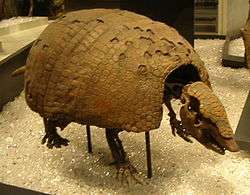Pampatheriidae
| Pampatheriids Temporal range: Oligocene–Pleistocene | |
|---|---|
 | |
| Holmesina occidentalis | |
| Scientific classification | |
| Kingdom: | Animalia |
| Phylum: | Chordata |
| Clade: | Synapsida |
| Class: | Mammalia |
| Order: | Cingulata |
| Family: | †Pampatheriidae Paula Couto, 1954 |
| Genera | |
Pampatheriidae ("Pampas beasts") is an extinct family of large plantigrade armored xenarthrans related to armadillos. However, pampatheriids have existed as a separate lineage since at least the middle Eocene Mustersan age, 45 to 48 million years ago.[2] Pampatheres evolved in South America during its long period of Cenozoic isolation. Although widespread, they were less diverse and abundant than the armadillos.[2] Holmesina spread to North America after the formation of the Isthmus of Panama as part of the Great American Interchange. They finally disappeared on both continents in the end-Pleistocene extinctions, about 12,000 years ago.
Description
Pampatheres are believed to have attained a weight of up to 200 kg (440 lb). Like three-banded armadillos, and unlike glyptodonts, their armored shell was given some flexibility by three movable lateral bands of scutes.[2] The osteoderms (bony plates in the skin comprising the armor) of pampatheres were each covered by a single keratinized scute, unlike osteoderms of armadillos, which have more than one scute.[2]

A study of pampathere jaw biomechanics showed that their masticatory musculature was more powerful and more adapted for transverse movements than that of armadillos, leading to the conclusion that much of their diet was coarse vegetation. They are thought to have been primarily grazers, unlike armadillos, which are omnivorous or insectivorous.[2] The variation between species in the expression of adaptations for grinding coarse vegetation correlates with the aridity of their habitat; such adaptations are most pronounced in Pampatherium typum, which lived in the arid Pampas, and least pronounced in H. occidentalis, which lived in humid lowlands.[3]
References
- ↑ Flávio Góis, Laureano Raúl González Ruiz, Gustavo Juan Scillato-Yané and Esteban Soibelzon (2015). "A Peculiar New Pampatheriidae (Mammalia: Xenarthra: Cingulata) from the Pleistocene of Argentina and Comments on Pampatheriidae Diversity". PLoS ONE. 10 (6): e0128296. doi:10.1371/journal.pone.0128296.
- 1 2 3 4 5 Vizcaíno, S. F.; De Iuliis, G.; Bargo, M. S. (1998). "Skull Shape, Masticatory Apparatus, and Diet of Vassallia and Holmesina (Mammalia: Xenarthra: Pampatheriidae): When Anatomy Constrains Destiny". Journal of Mammalian Evolution. 5 (4): 291–322. doi:10.1023/A:1020500127041. Retrieved 2011-10-20.
- ↑ De Iuliis, G.; Bargo, M. S.; Vizcaíno, S. F. (December 2000). "Variation in skull morphology and mastication in the fossil giant armadillo Pampatherium spp. and allied genera (Mammalia: Xenarthra: Pampatheriidae), with comments on their systematics and distribution". Journal of Vertebrate Paleontology. 20 (4): 743–754. doi:10.1671/0272-4634(2000)020[0743:VISMAM]2.0.CO;2. Retrieved 2010-10-21.
- Paleodatabase
- Encyclopedia of the Prehistoric World, By Douglas Palmer